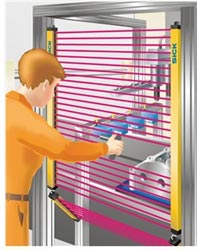
Posted to News on 19th Sep 2012, 05:41
What are EN ISO 13855:2010 stopping distances?
Seb Strutt, a Safety Specialist with Sick (UK), explains the new stopping distance requirements introduced in EN ISO 13855:2010.

On any machine or automated process, expert analysis of the operation will identify movements that are the key elements of a hazard. These are the elements that could constitute a 'clear and present danger' to the operator.
This danger means that there is no room for complacency regarding moving machinery and operatives. Although successive machinery safety legislation and associated technical standards in the EU have led to one of the most comprehensive safety regimes in the world, we still cannot sit back and assume all is right.
Safeguard positioning requirements
The introduction of EN ISO 13855:2010 Safety of machinery - positioning of safeguards with respect to the approach speeds of parts of the human body (BS EN ISO 13855:2010 in the UK), highlighted how machinery operators might put their safety at risk, without knowing it. In the same way as the reaction speed of a car's airbag under crash conditions is critical in limiting harm, so a machine designer must ensure a protective measure can react in time.
Incorrect positioning of the safety device (typically a safety light curtain, pressure-sensitive mat, two-hand start or an opening guard without locking) is one of the most common reasons for compliance failure. At Sick, we have observed this on countless occasions during initial safety inspections. Yet the provisions and implementation are simple, and compliance can easily be achieved.
EN ISO 13855:2010 is an excellent step forward and fills an important gap in the previous standard (EN 999:1998+A1:2008). What must be measured accurately, by a competent person, is the distance from the hazard point to the safety device, and its orientation relative to the hazard. However, the precision required for complex safe distance calculations, and the need for accuracy in estimating the safe stop time of the hazardous movement, can be critical to achieving safety compliance.
Achieving compliance with confidence
Manufacturer-derived safety distance calculation tools and stop time measurement services can remove the uncertainty from the required measurements, so the exact distances needed for compliance can be established. By taking advantage of these, or by using measurement services, the engineer can gain peace of mind and reduce the risk of an accident.
Identifying the minimum safe distance measurement is critical. At Sick we believe this to be so important that we offer our customers a stop time calculation service prior to and following the installation of new safety measures.
Positioning of protective devices
EN ISO 13855 applies to safety light curtains as well as to other devices such as pressure-sensitive mats, two-hand control systems and interlocking guards without guard locking. In simple terms, the standard is intended to ensure accessible hazards with mechanical movement are protected by electro-sensitive protective equipment (ESPE). A device of this type can detect an approach to the hazard and initiate a stop command that brings the mechanical motion to a safe condition before the operative can reach the hazard.
Distance calculations

For a vertical light curtain, the safety distance (Safety reach through, Srt) is calculated from the speed of approach (K) multiplied by the total response time of the protective measure(s) and machine (T), plus a constant (C) that depends on the specification of the light curtain:
Srt = (K * T) + C.
Note that the derivation of K, T and C can only be achieved by reference to EN ISO 13855:2010 or the operating instructions for the protective device(s).
With a multiple-beam light guard being used to detect full body access (typically with three or four beams), the equation becomes:
Srt = (K * T) + 850mm.
When using multiple beams, the minimum safety distance should be greater than 850mm to accommodate the arm length when reaching through the light beam grid.
The standard also describes the calculations to be performed when correctly positioning horizontal light curtains, safety mats and two-hand controls. The orientation and mounting height of the devices are important parameters in the calculation.
Eliminate hazardous reaching over

The reach over safety distance (Sro) is calculated by adding a specially measured constant (Cro) into the equation:
Sro = (K * T) + Cro.
Cro is found from the relevant table in EN ISO 13855:

Essentially, as a ready guide, areas of the table marked '0' show where the hazard cannot be accessed by overreaching. This means, for example, a hazard height of 800mm, with the upper edge of the light curtain detection zone at 1600mm, cannot be accessed by overreaching (see table above). The standard tackles in more detail under reach and indirect reach into hazardous areas. Note: the standard assumes that the operative is standing on the floor when reaching over. If it is likely that the operative might stand on a chair or other readily accessible object, then this should be taken into account when establishing safety distances.
If the standard Srt safety distance is also calculated for the machine safeguarding, the resultant safety distance adopted should be whichever is the greater, Srt or Sro. The results provide an immediate guide to the safe operation and safety status of the machine being assessed.
Follow the link for more information about safety services from Sick. Alternatively, to ask about about stop time calculations, compliance with EN ISO 13855:2010, or to discuss any other machinery safety requirements with Sick UK, contact Andrea Hornby on +44 (0)1727 831121 or email [email protected].
Want the latest machine building news straight to your inbox? Become a MachineBuilding member for free today >>

















